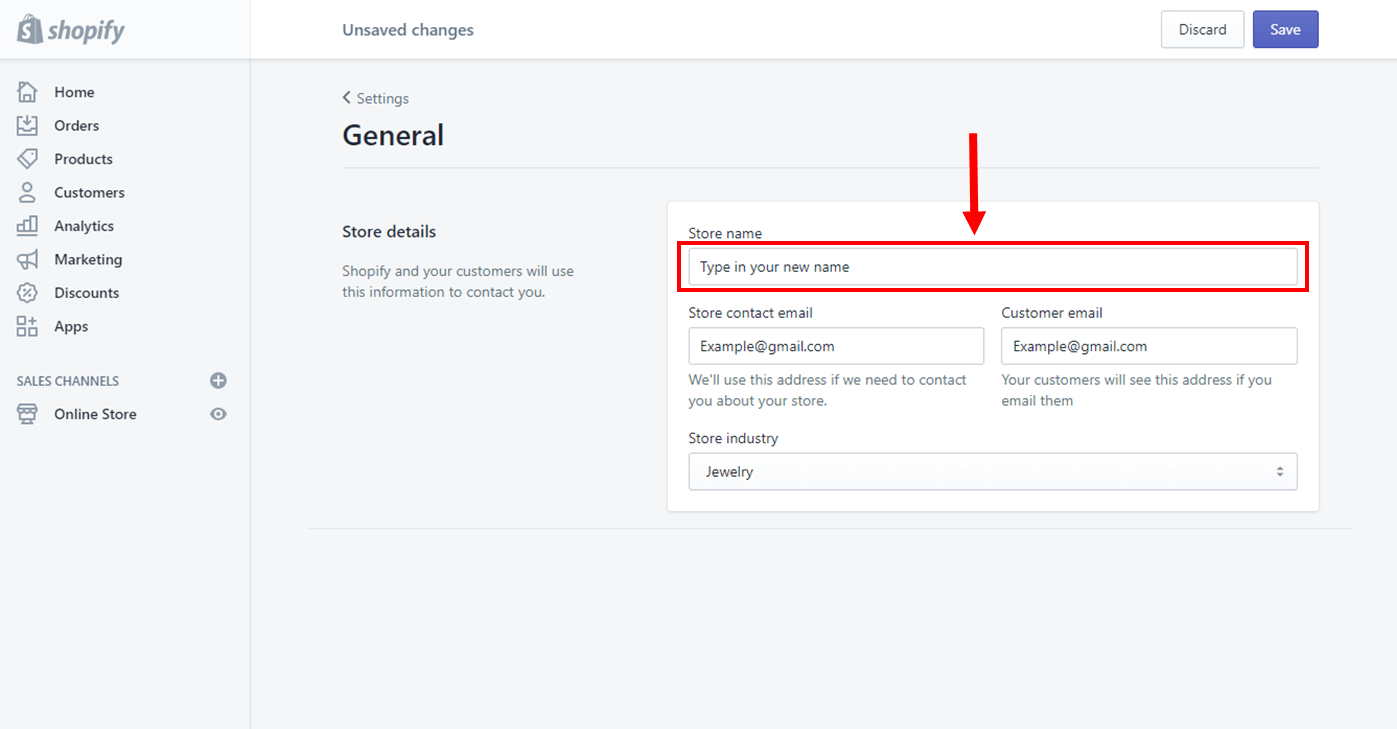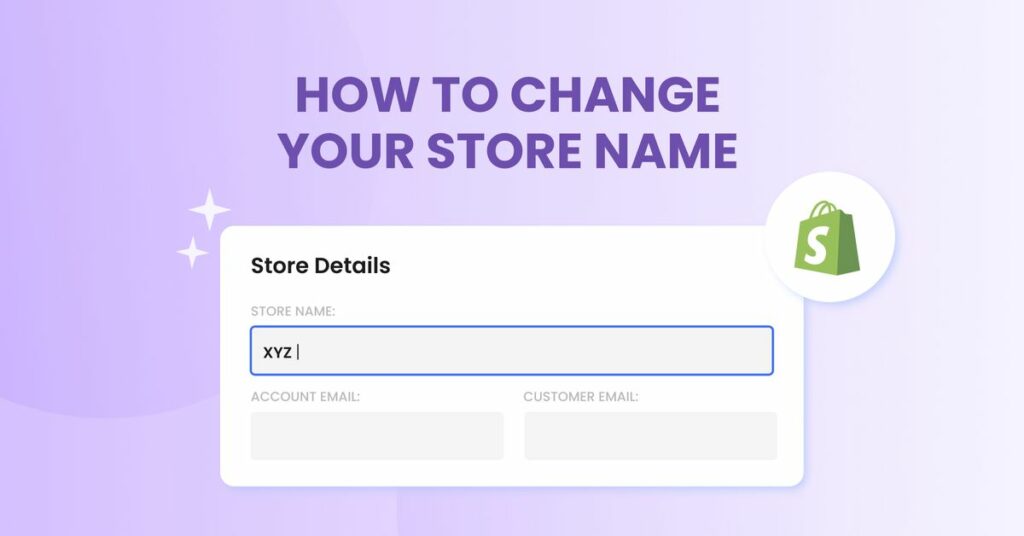Introduction
Welcome to a transformative journey in your brand's evolution! In this blog post, we explore the crucial aspect of changing your Shopify store name. Your store name is not just a label; it's a fundamental part of your brand identity. As businesses evolve, so should their names to align with their vision, mission, and the ever-changing market landscape. Join us as we delve into the importance of your store name, signs that indicate it's time for a change, and practical steps to make the transition seamlessly on Shopify. Let's embark on this exciting exploration of brand evolution!
Also Read This: Shutterstock Contributor Fund: Investing in the Creative Future
Importance of Your Store Name

Your Shopify store name is not just a string of characters; it's a vital component of your brand's identity and plays a crucial role in shaping customer perceptions. Let's dive into the multifaceted importance of your store name:
1. First Impression Matters
When potential customers come across your Shopify store, the first thing they encounter is your store name. This initial impression can significantly impact their decision to explore further or move on. A compelling and memorable name sets the stage for a positive customer experience.
2. Brand Recognition and Recall
Your store name is the cornerstone of your brand's recognition. It serves as a mental shortcut for customers, aiding in recall and fostering a sense of familiarity. A well-established and recognized brand name helps you stand out in a crowded market.
3. Reflecting Your Brand Identity
The right store name conveys your brand's personality, values, and the products or services you offer. It's an opportunity to create a strong connection with your target audience by aligning the name with your brand's ethos. Consider the tone, language, and emotions your name evokes.
4. Competitive Edge
In a competitive e-commerce landscape, a distinctive store name sets you apart from the competition. It helps create a unique selling proposition (USP) and can influence customers to choose your brand over others offering similar products or services.
5. Online and Offline Consistency
Consistency across online and offline channels is crucial for building a strong brand presence. Your store name should be easily transferable and adaptable, maintaining a unified identity whether customers encounter your brand on your website, social media, packaging, or in-store.
6. Legal and Trademark Considerations
Ensuring that your store name is legally sound and free from trademark conflicts is essential. A carefully chosen name reduces the risk of legal issues and protects your brand's reputation in the long run.
By understanding and leveraging the importance of your store name, you can create a solid foundation for your brand's success. In the next sections, we'll explore signs that indicate it's time for a change and guide you through the process of selecting a new, impactful name for your Shopify store.
Also Read This: Picture Analytics: Can I See How Many Views My iStock Pictures Get?
Signs It's Time for a Change

As your business evolves, so should your Shopify store name. Recognizing the signs that indicate it's time for a change is crucial for staying relevant and maintaining a strong brand presence. Here are key indicators that suggest a name change might be in order:
1. Shift in Business Focus or Offerings
If your business has expanded its product or service offerings or undergone a shift in focus, your current store name might no longer accurately reflect what you provide. Consider a name that aligns better with your current offerings and strategic direction.
2. Rebranding Initiatives
Undertaking a comprehensive rebranding effort, which includes changes in visual identity, messaging, and target audience, often necessitates a new store name. Ensure that your name aligns seamlessly with the updated brand image you're cultivating.
3. Outdated or Irrelevant Name
If your store name includes references that have become outdated or are no longer relevant to your audience, it's a clear sign for a change. Stay current and resonant by choosing a name that withstands the test of time and market trends.
4. Global Expansion
For businesses expanding globally, it's essential to consider cultural nuances and linguistic implications of the current store name. A name that may be well-received in one region could have unintended meanings or associations in another. Opt for a name that transcends cultural boundaries.
5. Poor Market Perception or Negative Feedback
If your store name has garnered poor market perception or consistently receives negative feedback, it's time to evaluate its impact on your brand. A fresh start with a new name can help distance your business from any previous challenges and present a positive image to customers.
6. Domain Availability Issues
With the digital landscape continuously evolving, securing a domain that aligns with your store name is crucial. If your current name poses challenges in terms of domain availability or conflicts with existing online entities, it's worth considering a change.
By paying attention to these signs, you can make informed decisions about whether a Shopify store name change is the right move for your business. In the next section, we'll explore actionable steps on how to choose a new name that resonates with your brand identity and goals.
Also Read This: Harnessing the Power of Flaticon API
How to Choose a New Name
Choosing a new name for your Shopify store is an exciting opportunity to redefine your brand and make a lasting impression. Here's a comprehensive guide on how to select a name that resonates with your brand identity and goals:
1. Define Your Brand Identity and Values
Start by clearly defining your brand's identity and values. Consider the emotions you want to evoke and the message you want to convey. A name aligned with your brand essence creates a strong foundation for customer connection.
2. Brainstorm Keywords and Concepts
Engage in brainstorming sessions to generate keywords and concepts related to your products, services, and brand personality. Use these as building blocks for your new name. Think about the qualities you want your business to be associated with.
3. Consider Memorability and Pronunciation
Choose a name that is easy to remember and pronounce. A memorable name increases the likelihood of customers recalling your brand when making purchasing decisions. Avoid complex spellings or ambiguous pronunciation.
4. Check Domain Availability
In the digital age, securing a matching domain is crucial. Check the availability of the domain corresponding to your desired name. Consistency across your online presence reinforces brand recognition and trust.
5. Ensure Legal Compliance
Before finalizing a name, conduct thorough research to ensure it is legally available and not already in use by another business. This step prevents potential trademark issues and legal complications down the road.
6. Test for Global Appeal
If your business has global aspirations, consider how the new name translates across different languages and cultures. Avoid unintended meanings or associations that may arise in diverse linguistic contexts.
7. Gather Feedback from Stakeholders
Involve key stakeholders, including team members, customers, and trusted partners, in the decision-making process. Collecting feedback provides valuable perspectives and ensures your new name resonates with your target audience.
Creating a new store name involves a thoughtful and strategic approach. By following these steps, you can navigate the process with confidence and select a name that not only reflects your brand's essence but also positions you for success in the competitive e-commerce landscape. In the next section, we'll guide you through the process of implementing the change on Shopify seamlessly.
Also Read This: eStockPhoto: Your High-Quality Travel and Nature Source
Implementing the Change on Shopify
Once you've chosen a new and compelling name for your Shopify store, the next crucial step is to seamlessly implement the change. Follow these step-by-step guidelines to ensure a smooth transition:
1. Backup Your Store Data
Before making any changes, ensure you have a comprehensive backup of your store data. This precautionary measure provides a safety net in case of any unforeseen issues during the transition.
2. Update Your Shopify Account Settings
Login to your Shopify admin panel and navigate to the "Settings" section. Update your store name in the "General" settings. This adjustment is critical for ensuring that your new name is reflected across your entire Shopify account.
3. Review and Update Marketing Materials
Go through your marketing materials, including business cards, flyers, and social media profiles. Update all instances of your old store name to maintain consistency in your brand messaging and visual identity.
4. Modify Your Website Content
Edit your website content to incorporate the new store name. This includes updating product descriptions, about us pages, and any other areas where the old name is mentioned. Pay attention to SEO elements to maintain search engine visibility.
5. Redirect Old URLs to New Ones
Set up 301 redirects for your old URLs to seamlessly guide visitors to the corresponding pages with the new store name. This step is crucial for preserving your search engine rankings and ensuring a positive user experience.
6. Communicate the Change to Customers
Proactively communicate the name change to your existing customer base. Use email newsletters, social media announcements, and website banners to inform customers about the rebranding. Assure them that the quality of products or services remains unchanged.
7. Monitor and Test
Regularly monitor your website and marketing channels after the change. Test different functionalities, forms, and links to ensure everything is working smoothly. Address any issues promptly to maintain a positive customer experience.
By following these implementation steps diligently, you can execute a successful name change on Shopify. Remember that a well-executed transition not only minimizes disruptions but also strengthens your brand's image. In the next section, we'll explore success stories of businesses that have successfully rebranded their Shopify stores.
Also Read This: The Top 10 Twitter Influencers You Should Follow for Social Media Insights
Success Stories
Embarking on a journey to change your Shopify store name can be a transformative experience, and many businesses have reaped significant rewards through successful rebranding. Let's delve into inspiring success stories that showcase the positive outcomes of strategic name changes:
1. Nike: From Blue Ribbon Sports to Global Icon
In 1971, Nike started as "Blue Ribbon Sports," a distributor for the Japanese shoemaker Onitsuka Tiger. After a rebranding effort in 1971, the company adopted the name Nike, inspired by the Greek goddess of victory. This change marked the beginning of Nike's ascent to becoming a global powerhouse in athletic footwear and apparel.
2. Apple Inc.: Reflecting Innovation and Simplicity
Originally named "Apple Computer, Inc.," the tech giant underwent a significant rebranding in 2007 when it dropped "Computer" from its name. This shift reflected the company's broader focus on innovation beyond computers. Today, Apple is synonymous with cutting-edge technology and sleek design across a diverse range of products.
3. Starbucks: Brewing a Global Community
When Starbucks opened its doors in 1971, it was known as "Starbucks Coffee, Tea, and Spices." The company dropped the reference to tea and spices in 1987 and simplified the name to "Starbucks Corporation" in 1988. This change allowed Starbucks to evolve beyond its original product range, creating a global community around the coffee experience.
4. Etsy: Crafting a Unique Marketplace
Originally named "EtsyStudio," the popular online marketplace for handmade and vintage goods shortened its name to simply "Etsy" in 2018. This streamlined approach reflected the platform's commitment to fostering a creative and unique marketplace, attracting a diverse community of sellers and buyers.
5. Domino's Pizza: Delivering More than Pizza
Domino's Pizza underwent a name change in 2012, dropping "Pizza" from its name to emphasize its expanding menu beyond pizza offerings. The rebranding aimed to position Domino's as a broader food delivery service. The change contributed to increased sales and customer engagement.
These success stories demonstrate the transformative power of a well-executed name change. By aligning the store name with the evolving identity and goals of the business, these brands have achieved heightened recognition, expanded market reach, and increased customer loyalty. In the final section, we'll address common questions and concerns in our FAQ, providing clarity and guidance for those considering a Shopify store name change.
Also Read This: Using Imago Stock Photos for Online Presence
FAQ
Considering a Shopify store name change raises various questions and concerns. Here, we address common queries to provide clarity and guidance throughout the process:
Q1: Why is it essential to change my Shopify store name?
A: Changing your store name can align your brand with evolving business goals, target audience preferences, and market trends. It's a strategic move to stay relevant and maintain a strong brand identity.
Q2: How can I ensure a new name is legally sound?
A: Conduct thorough research to ensure the availability of the new name. Check trademarks and register the domain. Consulting with legal professionals can provide added assurance and guidance in navigating potential legal complexities.
Q3: What if my customers don't like the new name?
A: Proactive communication is key. Inform your customers about the name change, highlighting the reasons behind it. Emphasize that the quality of your products or services remains unchanged. Most customers appreciate transparency and a well-explained rebranding effort.
Q4: How do I handle SEO during the transition?
A: Implement 301 redirects for old URLs to maintain SEO rankings. Update meta tags, headers, and content with the new name. Regularly monitor your website's performance and make necessary adjustments to ensure a smooth transition in search engine results.
Q5: Can I change my Shopify store name more than once?
A: While Shopify allows you to change your store name, frequent changes can be confusing for customers and affect brand consistency. Consider the long-term implications and thoroughly plan before deciding on a name change.
Q6: How long does it take for the new name to take effect?
A: The timeline for the new name to take effect can vary. Changes on your Shopify store can happen relatively quickly, but factors like domain propagation and SEO adjustments may take some time. Communicate the change proactively to manage customer expectations.
Q7: What if my desired domain is already taken?
A: Consider variations of the name, different domain extensions, or explore options to acquire the desired domain. It's important to choose a domain that closely aligns with your brand and is easily memorable for customers.
These FAQs aim to address common concerns associated with a Shopify store name change. If you have additional questions or require personalized guidance, consult with Shopify support or seek assistance from branding professionals to ensure a successful transition.
Conclusion
Congratulations on navigating the transformative journey of changing your Shopify store name! In this comprehensive guide, we explored the importance of your store name, identified signs indicating the need for a change, and provided actionable steps to choose and implement a new name seamlessly on the Shopify platform.
By understanding the significance of your store name, you've laid the foundation for a brand that resonates with your audience and stands the test of time. The success stories of renowned brands showcased the positive impact of strategic rebranding efforts, inspiring confidence in your own journey.
Remember to approach the process thoughtfully, considering legal aspects, customer perceptions, and the overall brand experience. Proactive communication with your audience can turn a name change into an opportunity to strengthen relationships and reinforce your commitment to delivering quality products or services.
As you implement the changes and witness the evolution of your brand, stay attuned to customer feedback, monitor performance metrics, and make necessary adjustments. A successful Shopify store name change is not just about a new label; it's a strategic move toward aligning your brand with your vision and the expectations of your target audience.
Should you encounter challenges or have additional questions, refer to our FAQ section or seek support from Shopify and branding professionals. Embrace the journey of brand evolution, and may your newly named Shopify store flourish and thrive in the dynamic world of e-commerce!












